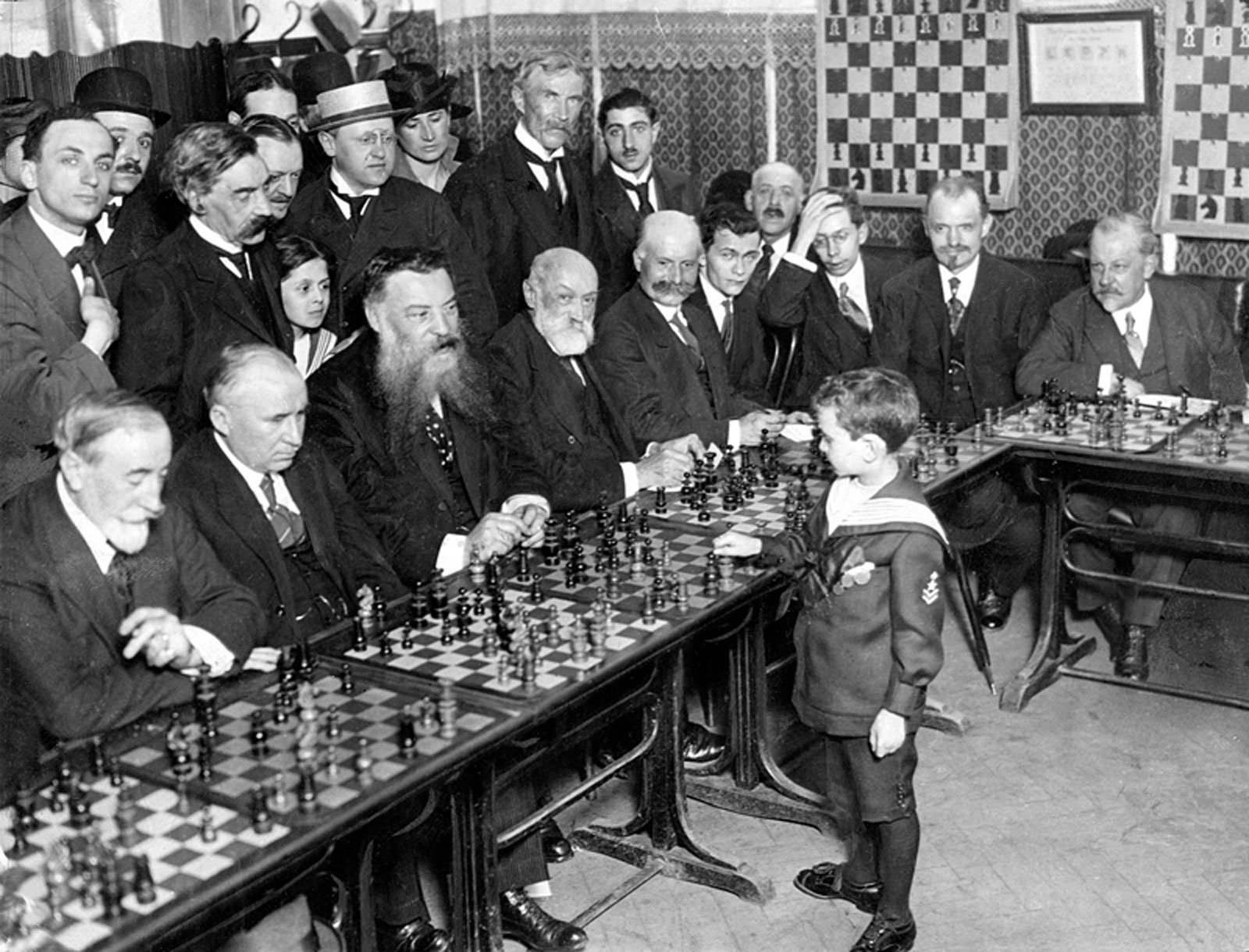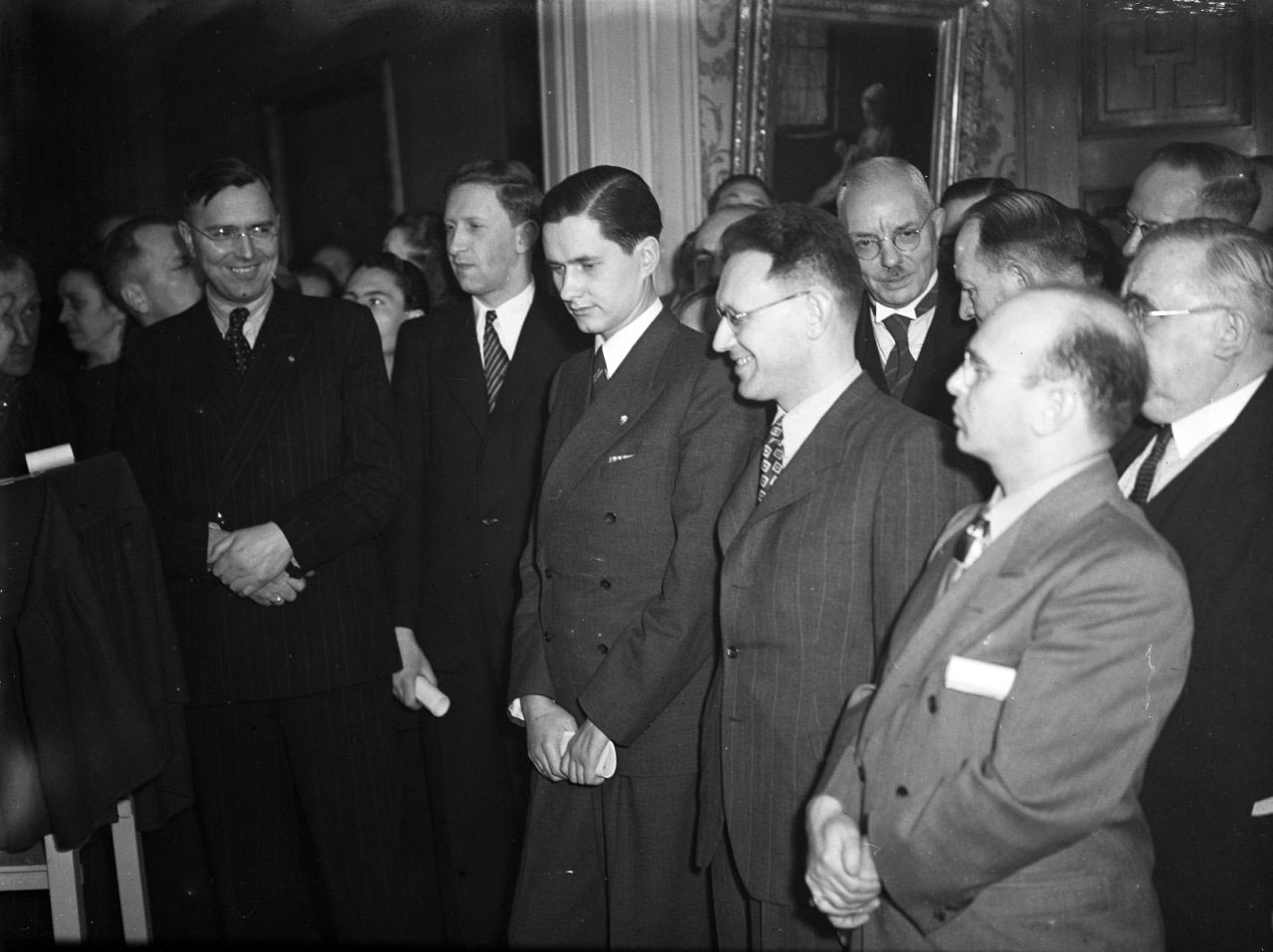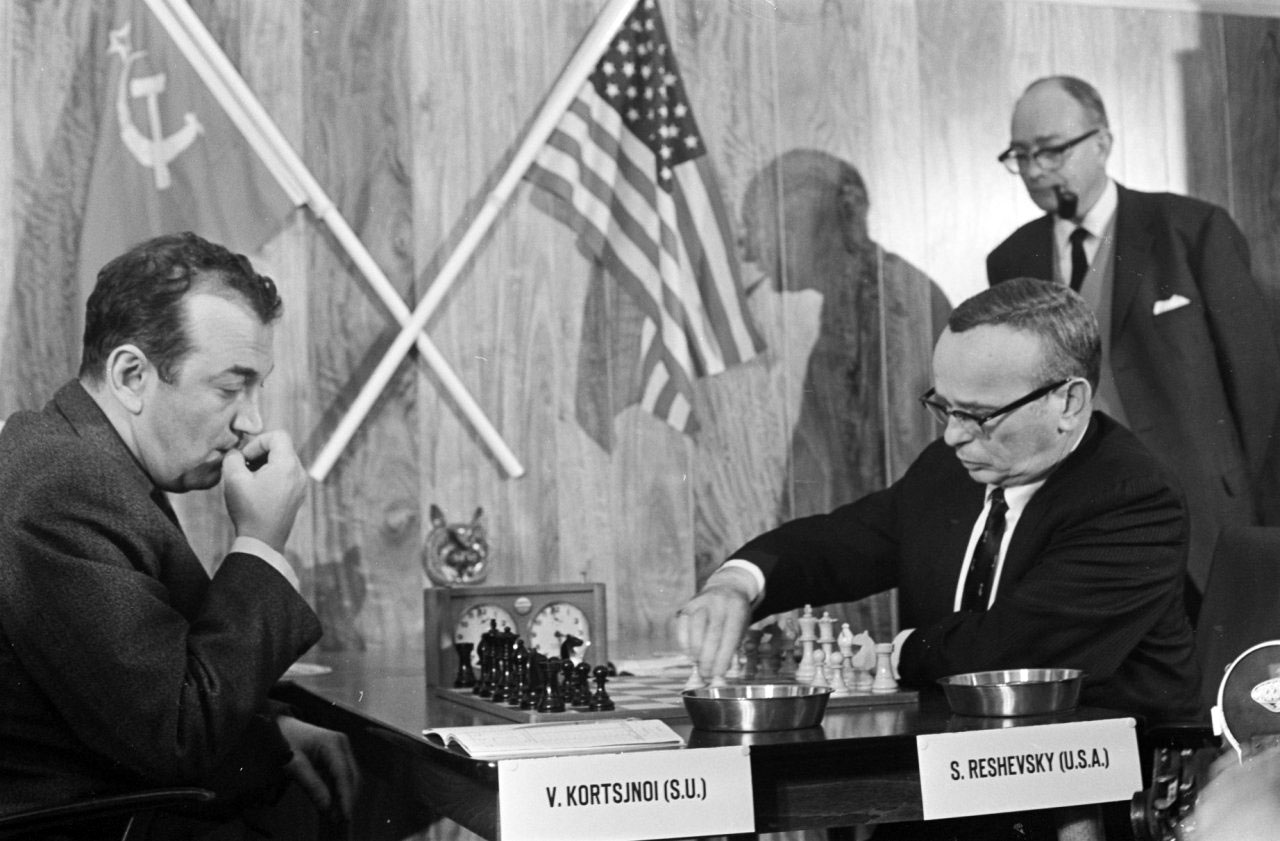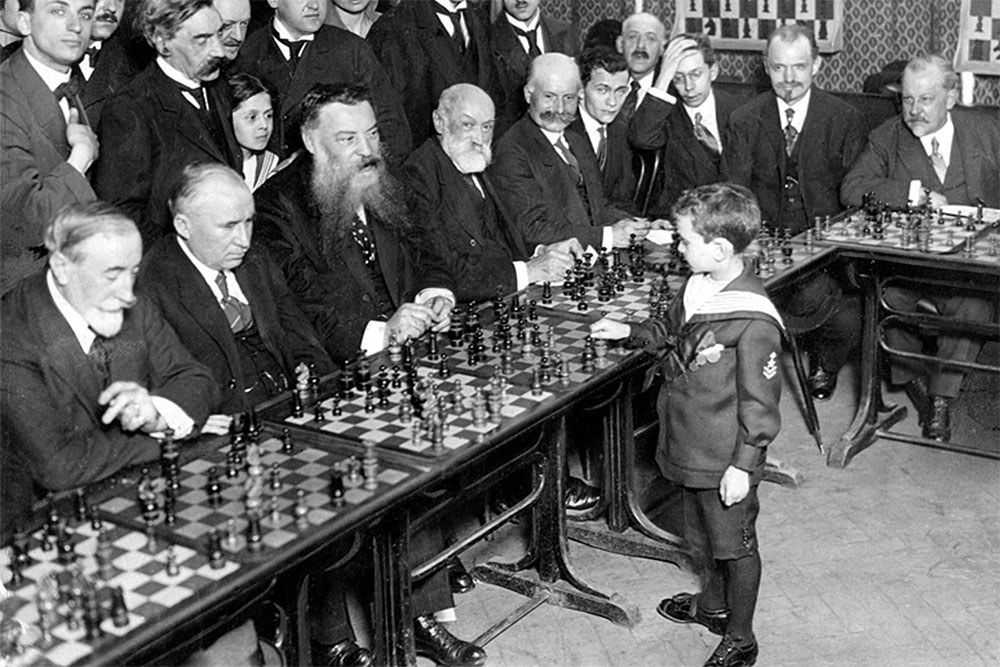A prodigy is born
Samuel Reshevsky was born on November 26th, 1911, in Ozorkow, Poland. He learned the game at age four, and was a chess prodigy of the highest standard, giving simuls at the age of eight around the world.
In November 1920, his parents moved to the U.S. to make a living by publicly exhibiting their child's talent. Reshevsky played thousands of games in exhibitions all over the U.S. In fact, for a while, Reshevsky did not even attend school, for which his parents appeared in District Court in Manhattan facing a charge of improper guardianship. However, Julius Rosenwald, wealthy co-owner of Sears, Roebuck and Company in Chicago, soon afterwards became Reshevsky's benefactor, and he guaranteed Reshevsky's future on the condition that he complete his education.

Reshevsky in 1920 (at age eight), giving a simultaneous chess exhibition in France | Photo: Kadel and Herbert
Reshevsky made good on this agreement and not only completed his secondary education, but attended the University of Chicago where he obtained a degree in accounting. During this period from 1924 to 1931, Reshevsky’s competitive chess was scarce, and though his ability was never in doubt, he was to support his wife and children throughout his life as a professional accountant.
Success in the US
In 1931, Reshevsky also made his first steps toward proper recognition for his chess genius and won the US Open Championship, then known as the Western Open. In 1934 he shared the US Open title with none other than Reuben Fine, himself one of the best players of the time. Reshevsky made an indelible mark on the US chess scene, notably winning the US Championship seven times outright, the first in 1936, and his last in 1969, 33 years later. Overall he played in 21 US Championships, with 15 top-three finishes, and a positive score in 20 of them.
In his first international foray in 1935, he won first place at the Margate International tournament where he beat among others Capablanca, A year later, in 1936, he placed third in the famous Nottingham Chess tournament, which included five past, present, and future world champions.
With famous classical examples from the works of the giants, the author talks in detail about principles of chess and methods of play that we can use during every stage of the game.
Although he played successfully in tournaments throughout his lifetime, he was the quintessential match player, and it was there that his skills stood out above all others. In 1941, he defeated I. A. Horowitz in a U.S. Championship playoff match by (+3 −0 =13). In 1942, he defeated Isaac Kashdan by (+6 −2 =3). In 1952, he defeated Svetozar Gligorić by (+2 −1 =7). In 1956, he defeated William Lombardy by (+1 −0 =5). In 1957, he defeated Arthur Bisguier by (+4 −2 =4). In 1957, he defeated Donald Byrne by (+7 −3 =0). In 1960, he defeated Pal Benko by (+3 −2 =5). In fact, in the USSR vs the USA match held in Moscow in 1955, Reshevsky played top board for the USA and defeated reigning world champion Mikhail Botvinnik over four games, winning one and drawing three.
World Championship contender
In 1948, Samuel Reshevsky was invited to play in the World Championship tournament, organized to determine the new champion after Alexander Alekhine, the previous titleholder, had died in 1946. This tournament was a five-player round-robin with each player playing each other five times, for a total of twenty games. Mikhail Botvinnik had arrived as the favourite by virtue of his pre-war results and his success at the 1946 Groningen tournament.

The five participants of the 1948 World Championship from left to right: Max Euwe, Vassily Smyslov, Paul Keres, Mikhail Botvinnik and Samuel Reshevsky. | Photo: J.D. Noske
While there is no question that all five participants, Botvinnik, Keres, Smyslov, Reshevsky and Euwe were worthy contenders, other names, even non-Soviets, certainly merited a chance of their own by virtue of their strength, such as Najdorf, Stahlberg, and Eliskases.

Smyslov barely overcame Reshevsky in their individual encounters | Photo: J.D. Noske
Nevertheless, the situation of the vacated title was unprecedented then, and the winner, Mikhail Botvinnik. truly was the best player of the day. None of the players went through the event unscathed, not even Botvinnik, who lost two games, one of which was to Samuel Reshevsky.
Mikhail Botvinnik 0-1 Samuel Reshevsky (la Hague 1948) - Annotated by Reshevsky

[Event "World-ch17"] [Site "The Hague/Moscow"] [Date "1948.04.18"] [Round "14"] [White "Botvinnik, Mikhail"] [Black "Reshevsky, Samuel Herman"] [Result "0-1"] [ECO "E29"] [Annotator "Reshevsky,S"] [PlyCount "83"] [EventDate "1948.03.02"] [EventType "tourn"] [EventRounds "25"] [EventCountry "URS"] [SourceTitle "MainBase"] [Source "ChessBase"] [SourceDate "1999.07.01"] [SourceVersion "2"] [SourceVersionDate "1999.07.01"] [SourceQuality "1"] 1. d4 Nf6 2. c4 e6 3. Nc3 Bb4 4. e3 {Botvinnik's favourite variation, which has earned him many triumphs. It is hard for Black to find a system of defence good enough to equalise. I devoted quite a lot of time to preparatory analysis of this line.} c5 5. a3 Bxc3+ 6. bxc3 {White has secured the advantage of the two bishops, but his queenside pawns are weak. If White can succeed in mobilising his bishops effectively, he would have the better of it. This was my main problem. (And his main aim in the long run is to exploit that weakened queenside - BHW)} Nc6 7. Bd3 O-O 8. Ne2 b6 9. e4 {Commencing an immediate attack on Black's king's wing.} Ne8 $1 {The best place for the knight, which usefully defends the g7 pawn for some time. (More to the point, it guards against threats of Bg5 and f4-f5-f6, and also facilitates Black playing f7-f5 - ed)} 10. Be3 {Forcing 10...d6 which blocks this square for the e8 knight which might want to go there to attack White's weak c4 pawn.} d6 (10... Qe7 { would not be good, for after} 11. dxc5 bxc5 12. Qa4 {Black cannot play 12...d6. }) 11. O-O Na5 12. Ng3 Ba6 13. Qe2 Qd7 14. f4 {[diagram]} f5 $1 ({Black pursues his plan methodically, to neutralise the effectiveness of White's bishops and with it the force of his kingside attack. If} 14... Qa4 {then} 15. f5 Bxc4 (15... exf5 16. exf5 Bxc4 (16... Nf6 17. Bg5) 17. f6 {with fine attacking chances}) 16. fxe6 Bxd3 (16... Bxe6 17. Bb5 Qb3 18. d5 Bc8 19. Bd2 { leaves it difficult for Black}) (16... fxe6 17. Rxf8+ Kxf8 18. Rf1+ Kg8 19. Qf3 Nf6 20. Bxc4 Qxc4 21. e5 {with a won game}) 17. Qxd3 {or 17 exf7+ with a superior position. This system of defence with ...Ne8 and ...f5 was tried out by Capablanca versus Johner at Carlsbad in 1929, as the editors of the bulletin point out.}) 15. Rae1 ({Waste of time.} 15. Rad1 {would have been better.}) (15. d5 {was another possibility but after} g6 16. dxe6 Qxe6 17. exf5 gxf5 {White's c4 pawn is under fire.}) 15... g6 16. Rd1 Qf7 ({If} 16... Qa4 { then} 17. d5 Bxc4 ({if} 17... exd5 18. exf5 $1) 18. dxe6 Bxe6 ({on} 18... fxe4 {would come} 19. e7 Rf7 20. Nxe4 Rxe7 21. Qf3 {threatening 22 Nf6+ and 23 f5 (but Fritz refutes this with} Bxd3 22. Nxc5 dxc5 23. Rxd3 Qe4 {winning - ed}) 19. exf5 gxf5 20. Bxc5 {, etc.}) 17. e5 Rc8 18. Rfe1 dxe5 ({If} 18... cxd4 19. Bxd4 Bxc4 20. exd6 Nxd6 {(a blunder - Fritz suggests 20...Qd7!? - ed), then} 21. Qe5 {, etc.}) 19. dxe5 (19. fxe5 {would lose a pawn after} cxd4 {.}) 19... Ng7 20. Nf1 Rfd8 21. Bf2 Nh5 22. Bg3 {A sad post for this bishop!} Qe8 23. Ne3 ({White would not ease his task of defence by the alternative} 23. Nd2 Qa4 {.}) 23... Qa4 24. Qa2 ({After} 24. Bc2 Qxa3 25. Rxd8+ Rxd8 26. Rd1 Nc6 27. Rxd8+ Nxd8 28. Qd2 Nf7 29. Qd7 Qxc3 {, Black would win.}) 24... Nxg3 25. hxg3 h5 $1 { Forestalling any attack by g4.} 26. Be2 Kf7 27. Kf2 Qb3 $1 {diagram} 28. Qxb3 Nxb3 29. Bd3 ({If} 29. Rd3 {, then} Nd2 {followed by ...Ne4+ and ...Bb7.}) 29... Ke7 30. Ke2 Na5 {Not allowing 31 Bc2.} 31. Rd2 Rc7 32. g4 Rcd7 ({White could have had drawing chances after} 32... fxg4 33. Bxg6 Nxc4 34. Nxc4 Bxc4+ 35. Ke3 {.}) ({After} 32... hxg4 33. Rh1 {is disagreeable.}) 33. gxf5 gxf5 34. Red1 ({There is no note to this move but it looks like 34 Red1 was a serious error and} 34. Rdd1 {should have been preferred. Black is still better but the position is by no means easy to win - ed.}) 34... h4 35. Ke1 ({An oversight in time trouble! The endgame is clearly won for Black already but better would have been} 35. Rh1 {... it is not clear whether this is Reshevsky or BH Wood writing, but Fritz provides the refutation to this alternative, namely} Bxc4 $1 {when} 36. Nxc4 Nxc4 37. Rdd1 Nb2 {wins material - ed.}) 35... Nb3 36. Nd5+ { Desperation.} exd5 37. Bxf5 Nxd2 38. Rxd2 dxc4 39. Bxd7 Rxd7 40. Rf2 Ke6 41. Rf3 Rd3 42. Ke2 0-1
Samuel Reshevsky was equal 3rd-4th with 10½/20, though it is worth noting that this was but half a point less than second place finisher Vasily Smyslov, who ended with 11.0/20.
Reshevsky was a serious contender for the World Championship from the mid-1930s until the mid-1960s, and it was in the near-legendary Candidates tournament in Zurich 1953 that Reshevsky probably had his best chance to qualify for a match for the absolute title. Although he finished in joint second with Bronstein and Keres, two points behind Smyslov, the truth is that he was the victim of a massive conspiracy to impede his victory.
The Soviet conspiracy
Bronstein, in his last book, Secret Notes, published in 2007 just after his death the previous year, confirmed long-standing rumours by writing that the nine Soviet grandmasters (out of a field of 15 players) at Zurich were under orders from both their chess leadership and the KGB to not let Reshevsky win the tournament under any circumstances, and that the Soviets prearranged several results in games amongst themselves to successfully prevent Reshevsky's overall victory. GM Alexei Suetin (who was the second of Tigran Petrosian at Zurich 1953), also confirmed the Soviet collusion in Zurich.
Reshevsky qualified for one more Candidates' in 1967 but lost the subsequent quarterfinal match to Viktor Korchnoi the following year in 1968.

Reshevsky finally succumbed in match play against a young Viktor Korchnoi, 20 years his junior | photo: Ron Kroon
Legacy
During his long chess career, Reshevsky played eleven of the first twelve World Champions, from Emanuel Lasker to Anatoly Karpov, the only player to do so. He defeated seven of them. His last great tournament victory was in 1984 when he won the Reykjavik Open at the ripe age of 72. He passed away in New York on April 4, 1992, at age 80.
During his career, Vlastimil Hort, who himself belongs to the same generation as Bobby Fischer, met no less than eight world champions over the board. In the early 60s he crossed swords with Mihail Tal, and at the end of the eighties he was sitting over the board from Garry Kasparov. Between the two there were meetings with chess legends Botvinnik, Petrosian, Smyslov, Spassky, Fischer and Karpov.
Editor's Note: Readers who objected to the missing mention of Steinitz will be happy to know this oversight will be rectified in the next edition of this series
Links




























